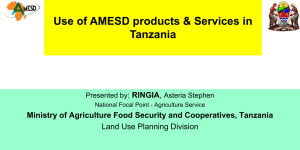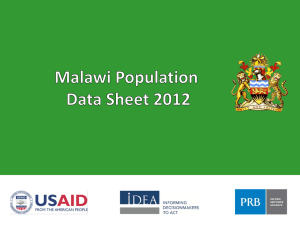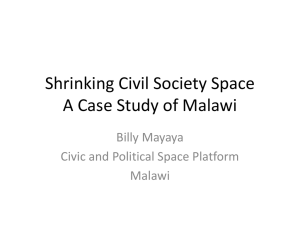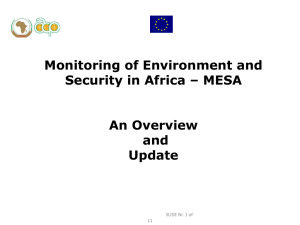Session5-Banda-LRCD-Malawi
advertisement
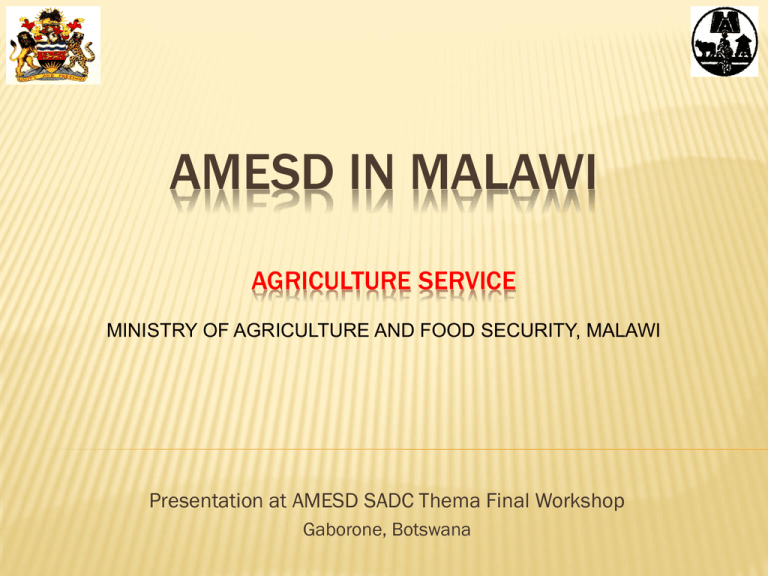
AMESD IN MALAWI AGRICULTURE SERVICE MINISTRY OF AGRICULTURE AND FOOD SECURITY, MALAWI Presentation at AMESD SADC Thema Final Workshop Gaborone, Botswana INTRODUCTION LRCD is one of the Departments in MoAFS It is responsible for promotion of programmes that ensure proper management of land based natural resources for improved agricultural production and other uses. VISION: ‘a nation with reduced land degradation’ INTRODUCTION… MISSION: To provide efficient and diversified services on environmental conservation to the land users for sustainable use of land based resources and socioeconomic development POLICY GOAL: Promote efficient and diversified and sustainable use of land based resources for both agriculture and other uses in order to avoid sectoral land use conflicts and ensure sustainable socio-economic growth and development FUNCTIONS Departmental core functions Development of policies and strategies relating to land resources management; Planning and coordination of programmes on land resource management; Provision of land resources information services; Monitoring and evaluating land use/cover changes; Provision of training in land resources management, and Provision of technical support in land resource management. OPERATIONS BEFORE AMESD Traditionally the department could only source remote sensing data from hard copy aerial photos and satellites images in hard copy which were generally outdated. TYPE OF AMESD SERVICE USED AS WELL AS THE PRODUCTS Agriculture service is being used for monitoring the state of crops and the environment. Basically for prediction of onset of rainfall. Vegetation index maps and graphs. Use of near real time remote sensing products Rainfall maps and graphs. USE OF AMESD PRODUCTS AND SERVICES Not much has been done on policy level, but the department provided data on NDVI to Bunda College of Agriculture and Total Land Care (NGO) (upon request). The data from the station was used in the Malawi Climate Change Program especially on land Use and Land Cover diagnostics. The data on Land Cover and NDVI helped out in determination of Land Cover Classification for Malawi for 2010 and also on Land cover change analysis for 2000 and 2010. (combination of SPOT and Landsat satellite images). USE OF AMESD PRODUCTS AND SERVICES The data received from this Station was used in Global Monitoring Food Security (GMFS) project currently underway in the Ministry of Agriculture. Not much done on the ground, since the system has been down for most part of the time. TRAINING/WORKSHOP 4 officers participated in the Distance Learning Course in GIS/Remote Sensing which was facilitated by ITC; 1 IT officer attended training for Systems Administrator in Pretoria; 2 Officers attended 1st and 2nd Regional trainings in Pretoria, South Africa; Conducted 1 briefing workshop for policy makers (26 policy makers attended); Conducted two national trainings with a total of 14 and 15 participants for the first and second trainings ,respectively; TRAINING/WORKSHOP….. Participants to workshop for policy makers TRAINING/WORKSHOP….. Participants to National Training #1 TRAINING/WORKSHOP Participants to NT2 CHALLENGES Unoperational status of the e-Station due to technical failure due to the absence of the Systems Administrator; Lack of faster internet to enable the users download the products from EMMA web; Frequent power outages affecting continuous data reception; WAY FORWARD There is need to train more than one Systems Administrator; If possible, MESA should assist in installation of a faster internet to enable users download products direct from the website if the e-Station is down; Alternative sources of power (e.g. solar power) need to be explored so as not miss any data; and In MESA, consider using higher resolution imagaes so that analysis can be done even for smaller areas. End of Presentation Thank you for your Attention


